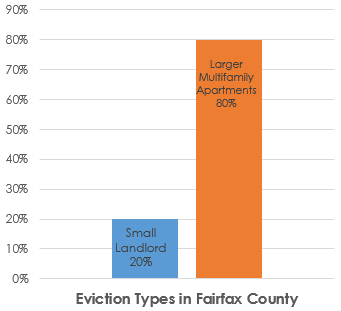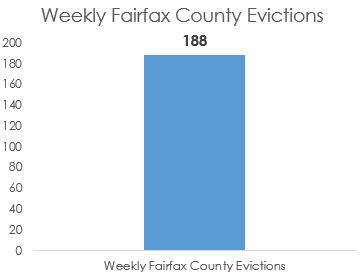In this series of articles, we will cover the basics of tenant eviction in Fairfax County and Northern Virginia for landlords going through the eviction process. In each of the major counties in NOVA: Fairfax County, Arlington, Alexandria, Loudoun and Prince William, the Virginia Residential Landlord and Tenant Act (VRLTA) of 2014 may or may not apply- and this law dictates how you can evict a tenant.
 In old classic movies the villain is sometimes an evil landlord—complete with a dark suit, moustache, and top hat—rubbing his hands together in gleeful anticipation of evicting a tenant. You may or may not have the suit, moustache, or top hat but if you are reading this, you probably have an eviction question. And the very last thing you feel is happiness… You are concerned: What grounds do I need to evict a tenant? What steps do I need to go through? How long does the eviction process take? How much will it cost? What are my legal rights as a landlord? Is this something I can do myself or do I need professional assistance?
In old classic movies the villain is sometimes an evil landlord—complete with a dark suit, moustache, and top hat—rubbing his hands together in gleeful anticipation of evicting a tenant. You may or may not have the suit, moustache, or top hat but if you are reading this, you probably have an eviction question. And the very last thing you feel is happiness… You are concerned: What grounds do I need to evict a tenant? What steps do I need to go through? How long does the eviction process take? How much will it cost? What are my legal rights as a landlord? Is this something I can do myself or do I need professional assistance?
 You are not alone with these questions. There were approximately 2.7 million evictions in America in 2015. (1) In our local area in the DMV, evictions are also common. Evictions in Fairfax County, for example, have averaged 188 per week according to recent court filings. That means there are roughly 9,000 to 10,000 evictions in Fairfax County each year. Many Fairfax County evictions are within large, multifamily apartments. Interestingly, smaller landlords and property investors make up roughly 20% of all evictions in Fairfax County, according to our recent review of public court records.
You are not alone with these questions. There were approximately 2.7 million evictions in America in 2015. (1) In our local area in the DMV, evictions are also common. Evictions in Fairfax County, for example, have averaged 188 per week according to recent court filings. That means there are roughly 9,000 to 10,000 evictions in Fairfax County each year. Many Fairfax County evictions are within large, multifamily apartments. Interestingly, smaller landlords and property investors make up roughly 20% of all evictions in Fairfax County, according to our recent review of public court records.
DOES THE VIRGINIA RESIDENTIAL LANDLORD AND TENANT ACT APPLY TO ME?
Rental property in Virginia can fall under either the VRLTA or common law, and while many rules are similar, there can be differences in what is allowable for the landlord.
In Virginia, if you are a 1) “natural person” under the law- which basically means you a person, not a corporation. —This definition includes individual property owners, multiple property owners, and also includes trustees, limited liability companies, and partnerships-- as defined in the VRLTA, 2) rent out three or more single family properties and 3) entered into the lease on or after July 1, 2014, you fall under VRLTA rules. The single family property definition includes condominiums. For rental agreements entered into prior to July 1, 2014, you fall under VRLTA rules if you rent out four or more single family properties.
The VRLTA enumerates applicable rules, time frames, and procedures to follow for eviction. Landlords not subject to the VRLTA follow common law, which is based on legal precedence developed over hundreds of years. In many situations, common law and VRLTA are the same but this is not always the case. Also, it is important to remember that there are certain actions that are never permissible to the landlord holding residential property, such as turning off utilities or changing locks while the tenant is still living in the property. (2)
Most counties in Virginia have their own unique procedures and schedules for handling evictions within their local courts and in their local police departments. But regardless of your county, the VRLTA and common law are applied the same across all areas of the Commonwealth. For example, if you are evicting a tenant in Fairfax County, you will likely attend the court hearing in room 2A or 2B, on most Fridays. Large multifamily owners tend to be called first (because their attorneys group cases) and then smaller Fairfax County landlords will follow towards the later half of the docket.
REASONS TO EVICT A TENANT AND NOTICES
There are four reasons in Virginia that a tenant can be evicted under both the VRLTA and under common law: 1) Nonpayment of rent, 2) Noncompliance with the lease that can be remedied, and 3) Noncompliance of the lease that cannot be remedied or recurrent violations, and 4) Violation of the law.
Nonpayment of Rent
-The most common reason for eviction is non-payment of rent in the United States and that is true locally as well. In our experience in the DC Metro area, the vast majority of evictions are for nonpayment of rent. If the tenants have not paid their rent by the due date as specified in the lease or rental agreement, the landlord has the right to furnish them with a written “5 Day Notice to Pay or Quit.” This gives the tenant five days from the receipt of the notice to pay the rent in full. Non-payment of other costs that the tenant is obligated in the lease to pay to a third party (such as condo fees, utilities, or taxes) are also covered by the Pay Rent or Quit rule. If the rent check “bounced” due to nonsufficient funds, the landlord has the right to require that the rent due be paid in cash, cashier’s check, or a certified check. (3)
Sometimes the tenant would like to make a partial payment of the rent due and the landlord must make a decision as to whether to accept a partial payment. This is a situation where the landlord must use their own judgement. If the renter is a good, long-time tenant and has had an unusual urgent situation in the past month—such as unexpected medical bills or automobile damage-- you may be tempted to allow them to make partial payments in order to retain them. Under the law, you are under no obligation to accept partial payments at any time before or after the due date of the rent. In general, we advise landlords not to permit these types of situations.
Never accept a check for partial payment with the words, “Full payment” or similar language written on it. In that case, the correct course of action is to return the check with a letter explaining that you are rejecting it. If you do accept a partial payment, provide a written notice within five business days to the tenant that you as the landlord reserve your rights as enumerated in the “Pay Rent or Quit” notice. This written notice must be repeated after each partial payment. (4) Overall, it is safer and simpler as a landlord to never accept partial payments. (5) If you continue to have questions in this contentious area, it is best to consult a professional attorney if you need guidance on your exact situation
The five day notice is required both under both the VRLTA and common law (6). The 5 Day Notice to Pay or Quit is written documentation that an eviction action will commence after 5 days if that full payment is not made within that time.
Non-Compliance with Lease that can be remedied
If the tenant violates the lease, but that violation is something that can be remedied, the landlord can issue a “Notice to Cure Default,” also called a Notice to Cure or Quit. The notice specifies that remedy must be made within 21 days. If the tenant has not remedied the situation, they must vacate the property before 30 days or eviction procedures can begin. Examples of this type of violation would be keeping a pet in violation of the lease, minor property damage, or excessive loud noise that disturbs the neighbors. The Notice to Cure Default is written documentation that, if the violation is not remedied within 21 days and the tenant still remains in the property, an eviction action will commence after 30 days. The 21/30 day notice is prescribed by the VRLTA (7) but common law only requires that the notice be “reasonable.” As a practicality and to be on the safe side, it would be advisable to follow VRLTA guidance in this area, even if the rental does not fall under VRLTA.
Recurring Non-Compliance with Lease or Non-Compliance that cannot be remedied
The landlord may issue a “30-Day Recurring Breach Notice” if the tenant repeatedly violates the lease, even if they had previously remedied it under the 21 day notice. In that case, the landlord may decide that the tenant needs to leave, so they do not have to deal with the same issue again and again. This notice gives the tenant 30 days to vacate the premises or face eviction.
Similarly, the landlord may issue a “30-Day Notice to Quit” (also called a 30-Day Notice to Vacate) if the tenant violates the lease and that violation cannot be cured, such as major property damage or ongoing harassment of other tenants. This provides notification to the tenant that they must vacate the property within 30 days or that eviction procedures will begin. The 30 day notice is prescribed by the VRLTA but common law states only that the notice be reasonable. However, as with the 21/30 notice, it would be advisable to follow VRLTA guidance in this area.
Criminal Activity
If the tenant is using the property to engage in criminal activity, such as illegal drug activity, the landlord may begin eviction procedures immediately and is not required to give notice. (8)
HOW TO DELIVER THE NOTICES
Virginia allows several methods to deliver the various notices listed above. The notice may be hand delivered to the tenant, hand delivered to a family member living at the property who is over the age of 16, posted on the door if no one suitable is at home, sent via regular first class mail or certified mail. It is wise to use a method that will provide you with a receipt. As a landlord, it is critical that the delivery of the notice cannot be disputed or called into question.—Consider taking a witness along on a hand delivery or requesting a return receipt for certified mail.(9)
The landlord may request that the county sheriff deliver an eviction notice (Section 55- 248.31:1). In Fairfax County, the landlord must provide the sheriff with the name of the individual(s) to be served, the address of the rental property, the original notice for return to landlord, and a copy for each individual being served, a self-addressed, stamped envelope to send back landlord's proof of service, and a $12.00 service fee for each individual being served. (10)
NOTE REGARDING THE TENANT’S PERSONAL PROPERTY
As you see in the sample forms, you should address the issue of the tenant’s personal property in the various notices by adding a statement that the tenant has 24 hours after their residency terminates to remove personal property. Both common law and VRLTA require this statement. (11) After 24 hours the landlord may dispose of the property. To learn more, read our next article, Tenant Eviction Part 2, which will address your next steps in the tenant eviction.
Remember:
Our goal is to provide you with the basic knowledge needed to navigate the eviction process and to suggest resources for more complex situations. We are not lawyers, but we hope we can provide a useful overview to you, outline the overall process, make you aware of the necessary steps, and help you avoid potential pitfalls throughout the eviction process. Please remember that it is important for landlords to consult professionals and your local government when necessary.
Customer Results Property Management is always more than happy to assist you with managing your rental properties. We have many years of experience in residential property management in the Northern Virginia area. Please don’t hesitate to call us at 703-382-2325 if you have questions or contact us on our site, CustomerResultsPropertyManagement.com
(1)Troy McMullen, “Why More Americans are Facing Eviction,” http://www.forbes.com/sites/troymcmullen/2016/12/12/why-more-americans-are-facing-eviction/#385b48aed183 (December 12, 2016)
(2) Jerome P. Friedlander, II, The Basics of Landlord and Tenant Law, (McLean: Peppercorn Paperworks LLC, 2015) Supp 2011, Table CL-8
(3) Friedlander, The Basics of Landlord and Tenant Law, Supp 2008, P 50
(4) Friedlander, The Basics of Landlord and Tenant Law, Supp 2004, P 92-93
(5) Agodoni, Laura, “Don’t Accept a Partial Rent Payment After the Due Date,” https://www.landlordology.com/partial-rent-payment/ (December 9, 2016)
(6) Friedlander, The Basics of Landlord and Tenant Law, Supp 2011, Table CL-8
(7) Friedlander, The Basics of Landlord and Tenant Law, Supp 2011, Table CL-8
(8) Dillman, Beth “The Eviction Process in Virginia: Rules for Landlords and Property Managers,” http://www.nolo.com/legal-encyclopedia/the-eviction-process-virginia-rules-landlords-property-managers.html (2016)
(9) Friedlander, The Basics of Landlord and Tenant Law, Supp 2003, 117
(10) “Eviction Procedures”, http://www.fairfaxcounty.gov/sheriff/eviction.htm
(11) Friedlander, The Basics of Landlord and Tenant Law, Supp 2011, Table CL-8




